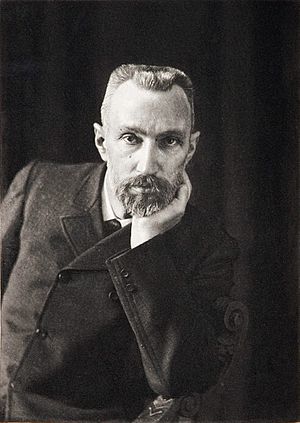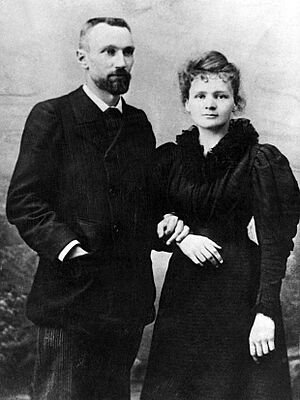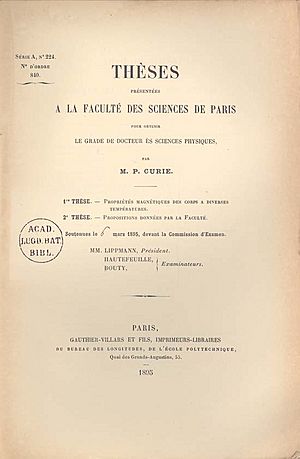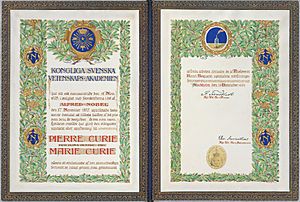Pierre Curie facts for kids
Quick facts for kids
Pierre Curie
|
|
|---|---|

Curie, c. 1906
|
|
| Born | 15 May 1859 Paris, France
|
| Died | 19 April 1906 (aged 46) Paris, France
|
| Alma mater | University of Paris |
| Known for |
|
| Spouse(s) | |
| Children | |
| Awards |
|
| Scientific career | |
| Fields | Physics, chemistry |
| Institutions | University of Paris |
| Thesis | Propriétés magnétiques des corps à diverses températures (Magnetic properties of bodies at various temperatures) (1895) |
| Doctoral advisor | Gabriel Lippmann |
| Doctoral students | |
| Signature | |
 |
|
Pierre Curie (born May 15, 1859 – died April 19, 1906) was a French physicist. He was a pioneer in studying crystallography (the science of crystals), magnetism, piezoelectricity, and radioactivity. In 1903, he won the Nobel Prize in Physics. He shared this award with his wife, Marie Skłodowska–Curie, and Henri Becquerel. They were honored for their amazing work on radiation.
Pierre and Marie Curie were the first married couple ever to win a Nobel Prize. This started a famous family tradition, as the Curie family went on to win five Nobel Prizes in total!
Contents
Early Life and Education
Pierre Curie was born in Paris, France, on May 15, 1859. His father, Eugène Curie, was a doctor. Pierre was taught at home by his father. From a young age, he was very good at math and geometry.
When he was 16, he earned his Bachelor of Science degree in mathematics. By the time he was 18, he had earned a license in physical sciences from the Sorbonne. This is similar to a master's degree in the U.S. He worked as a lab instructor because he didn't have enough money to continue his studies right away. In 1895, he finally earned his doctorate degree from the University of Paris. His doctoral research was all about magnetism. After getting his doctorate, he became a physics professor.

In 1880, Pierre and his older brother, Paul-Jacques, made an important discovery. They showed that certain crystals create an electric charge when you squeeze them. This effect is called piezoelectricity. To help with their work, they invented a special tool called the piezoelectric quartz electrometer. The next year, they showed the opposite effect: crystals could change shape when an electric field was applied to them. Today, almost all digital electronic devices use this idea in things like crystal oscillators.
Pierre Curie met Maria Skłodowska through a friend. He invited her to work in his laboratory as a student. He was very impressed by her dedication to research. He proposed to her, and they married on July 26, 1895. They had a very happy and loving marriage.
Amazing Scientific Research
Before his famous work on magnetism, Pierre Curie designed a very sensitive tool. It was a torsion balance used to measure magnetic properties of materials. Other scientists later used similar versions of this equipment.
For his doctoral research, Pierre Curie studied different types of magnetism, like ferromagnetism, paramagnetism, and diamagnetism. He found out how temperature affects paramagnetism. This discovery is now known as Curie's law. The constant number in Curie's law is called the Curie constant.
He also discovered that certain magnetic materials lose their magnetic properties above a specific temperature. This special temperature is now called the Curie temperature. The Curie temperature is used in many fields, from studying Earth's plate tectonics to understanding magnetic fields in space.
The "Curie" is a unit of measurement for how strong a radioactive material is. It was named after Marie and Pierre Curie in 1910 to honor their work.
Pierre Curie also came up with an idea called the Curie Dissymmetry Principle. This principle states that a physical effect cannot have a lack of symmetry if its cause also lacks that symmetry. For example, if you have a random mix of sand, it looks the same from all directions. But if you add gravity, which has a direction, the sand grains can sort themselves by density. This new arrangement, with layers of sand, shows the same directionality as the gravitational field that caused it.

Pierre Curie worked closely with his wife, Marie, to find and separate two new elements: polonium and radium. They were the first to use the word "radioactivity" to describe the energy given off by these elements. Their pioneering work, including Marie Curie's famous doctoral research, used a sensitive piezoelectric electrometer that Pierre and his brother Jacques had built.
In 1898, Pierre, Marie, and M. G. Bémont published their discovery of radium and polonium. This discovery was later recognized with a special award for chemical breakthroughs in 2015.
In 1903, the Royal Society of London invited Pierre to talk about their research. Marie Curie was not allowed to give the lecture herself, so Lord Kelvin sat next to her while Pierre spoke. After this, Pierre and Marie were given the Davy Medal. In the same year, Pierre and Marie Curie, along with Henri Becquerel, received the Nobel Prize in Physics for their groundbreaking work on radioactivity.
Pierre Curie and his student, Albert Laborde, made another important discovery. They found that radium particles continuously give off heat. This was the first time anyone observed nuclear energy. Curie also studied the different types of radiation from radioactive substances. Using magnetic fields, he showed that some radiation had a positive charge (called alpha), some had a negative charge (called beta), and some had no charge (called gamma radiation).
The Curie Family
Pierre Curie's family had a history of notable people. His grandfather, Paul Curie, was a doctor. Pierre is also a direct descendant of the famous scientist and mathematician Jean Bernoulli.
Pierre and Marie Curie's daughter, Irène, and their son-in-law, Frédéric Joliot-Curie, also became physicists. They continued to study radioactivity and each won Nobel Prizes for their work!
Their other daughter, Ève, wrote a well-known book about her mother. She was the only member of the Curie family who did not become a physicist. Ève married Henry Richardson Labouisse, Jr., who received a Nobel Peace Prize on behalf of Unicef in 1965.
Pierre and Marie Curie's granddaughter, Hélène Langevin-Joliot, is a professor of nuclear physics at the University of Paris. Their grandson, Pierre Joliot, named after Pierre Curie, is a famous biochemist.
Death and Legacy
Pierre Curie died in a street accident in Paris on April 19, 1906. He was crossing a busy street in the rain when he slipped and fell under a heavy horse-drawn cart. One of the wheels hit his head, killing him instantly. His father and lab assistant believed that Pierre's deep thoughts and absent-mindedness might have contributed to the accident.
Both Pierre and Marie Curie were exposed to large amounts of radiation during their research. They suffered from radiation sickness. Marie Curie later died in 1934 from a blood disease caused by radiation. Even today, their papers from the 1890s are too dangerous to touch. Their laboratory notebooks are kept in special lead boxes, and people who want to see them must wear protective clothing.
If Pierre Curie had not died in the accident, it is very likely he would have also died from the effects of radiation, just like his wife, their daughter Irène, and her husband Frédéric Joliot.
In April 1995, Pierre and Marie Curie were moved from their original burial place. They were reburied in the crypt of the Panthéon in Paris, a special place for honoring important French figures.
Awards and Honors
- Nobel Prize in Physics, with Marie Curie and Henri Becquerel (1903)
- Davy Medal, with Marie Curie (1903)
- Matteucci Medal, with Marie Curie (1904)
- Elliott Cresson Medal (1909) – awarded after his death during Marie Curie's award ceremony
- Citation for Chemical Breakthrough Award from the Division of History of Chemistry of the American Chemical Society (2015)
Images for kids
-
Pierre and Marie Skłodowska-Curie, 1895
-
Pierre and Marie Curie in their laboratory
See also
 In Spanish: Pierre Curie para niños
In Spanish: Pierre Curie para niños










